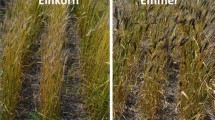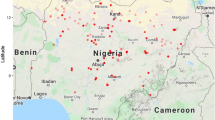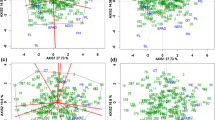Abstract
In-depth information on plant phenology of einkorn (Triticum monococcum L. subsp. monococcum) and emmer, (Triticum turgidum subsp. dicoccun (Schrank) Thell) germplasm is indispensable for better utilization of their available genetic resources as underutilized crops, especially under abiotic stress. Whereas; optimization of their phenology is one of the most effective strategies to achieve this goal as it is a key factor for crop adaptation under abiotic stress. The objectives of this study were to integrate quantitative phenotyping methods to describe and explain phenotypic and genotypic differences or similarities in phenological stages within vegetative and reproductive growth phases between einkorn and emmer germplasm; identify combinations of discriminating traits between einkorn and emmer germplasm at successive phenological growth stages; and estimate multivariate distances between einkorn and emmer germplasm based on their geographical sources and stage of genetic improvement. The evaluated germplasm represented a wide range of geographical origins in the Fertile Crescent of West Asia, East Africa, West and East Europe, and North America. The study developed a method for accurate estimation of synchrony and duration of phenological growth stages of the diverse germplasm; and presented a ‘sliding’ scale capable of discriminating between different ‘maturity classes’ of the species on the basis of five phenology indicators, vis: growing degree days in conjunction with plant height, normalized difference vegetative index, color space coordinates, and green gradient-based canopy segmentation. Reliable relationship was established between visual scoring and color measurements of plants based on digital images at different growth stages. This relationship may become useful for research and crop management in resource-limited areas. Accurate prediction of phenological growth stages of einkorn and emmer wheat is essential, not only for ideotype development through simulation and modeling of weather and management effects, but also to help establish a cottage industry to benefit small-scale farmers, and to improve and maintain high-quality end products from these underutilized wheat genetic resources.










Similar content being viewed by others
Abbreviations
- a:
-
Green (negative)–Reddish (positive) color space coordinate
- b:
-
Blueish (negative)–Yellowish (positive) color space coordinate
- BT:
-
Boosted trees
- CFA:
-
Confirmatory factor analysis
- C:N:
-
Carbon-to-nitrogen ratio
- CIELab:
-
Combined color space coordinates
- ECa:
-
Apparent soil electrical conductivity (dS m−1)
- EGV:
-
Early growth vigor
- GCV:
-
Genotypic coefficient of variation
- GDD:
-
Thermal time in growing degree days
- GFP:
-
Grain filling period
- GS31:
-
Early stem elongation stage
- GS39:
-
Late stem elongation stage
- GS49:
-
Booting stage
- GS57:
-
Heading stage
- GS65:
-
Anthesis stage
- GS89:
-
Physiological maturity stage
- GYI:
-
Grain yield index
- h 2 :
-
Narrow-sense heritability estimate
- L:
-
Dark (zero)–White (100) color space coordinate
- Lab:
-
Color space coordinates (i.e., combined estimates of L, a, and b, above)
- MDS:
-
Multi-dimensional scaling
- NDVI:
-
Normalized difference vegetation index
- PGR:
-
Plant genetic resources
- PH:
-
Plant height
- PTQ:
-
Photothermal quotient
- PC:
-
Principal component
- PCV:
-
Phenotypic coefficient of variation
- PLSR:
-
Partial least squares regression
- RGB:
-
Red, green, blue light spectrum
- RMA:
-
Reduced major axis
- RUE:
-
Radiation use efficiency (g MJ−1)
- SI:
-
Senescence index
- SPAD:
-
Soil plant area development
- SG:
-
Stay green
- SVM:
-
Support vector machine
References
Adu MO, Sparkes DL, Parmer A, Yawson DO (2011) ‘Stay green’ in wheat: comparative study of modern bread wheat and ancient wheat cultivars. APRN J Agric Biol Sci 6:16–24
Ahlawat S, Chhabra AK, Behl RK, Bisht SS (2008) Genotypic divergence analysis for stay green characters in Wheat (Triticum aestivum L. em. Thell). S Pac J Nat Appl Sci 26:73–81
Aslam MA, Ahmad M, Stöckle CO, Higgins SS, Hassan F, Hayat R (2017) Can growing degree days and photoperiod predict spring wheat phenology? Front Environ Sci 5:57. https://doi.org/10.3389/fenvs.2017.00057
Barutcular C, Toptas I, Turkten H, Yildirim M, Koc M (2014) SPAD greenness to estimate genotypic variation in flag leaf chlorophyll in spring wheat under Mediterranean conditions. Turk J Field Crops 20:1–8
Brandolini A, Volante A, Heun M (2016) Geographic differentiation of domesticated einkorn wheat and possible Neolithic migration routes. Heredity 117:135–141. https://doi.org/10.1038/hdy.2016.32
Brown TA, Jones MK, Powell W, Allaby RG (2008) The complex origins of domesticated crops in the Fertile Crescent. TREE. https://doi.org/10.1016/j.tree.2008.09.008
Cattani CE, Garcia MR, Mercante E, Johann JA, Correa MM, Oldoni L (2017) Spectral-temporal characterization of wheat cultivars through NDVI obtained by terrestrial sensors. Rev Brasil Eng Agric Ambi 21:769–773
Cernadas E, Fernández-Delgado M, González-Rufino E, Carrión P (2017) Influence of normalization and color space to color texture classification. Pattern Recognit 61:120–138. https://doi.org/10.1016/j.patcog.2016.07.002
Coblentz WK, Akins MS, Kalscheur KF, Brink GE, Cavadini JS (2018) Effects of growth stage and growing degree day accumulations on triticale forages: 1. Dry matter yield, nutritive value, and in vitro dry matter disappearance. J Dairy Sci 101:8965–8985. https://doi.org/10.3168/jds.2018-14868
Corti M, Cavalli D, Cabassi G, Gallina PM, Bechini L (2018) Does remote and proximal optical sensing successfully estimate maize variables? A review. Eur J Agron 99:37–50. https://doi.org/10.1016/j.eja.2018.06.008
Dar E, Brar AS, Yousuf A (2018) Growing degree days and heat use efficiency of wheat as influenced by thermal and moisture regimes. J Agrometeorol 20:168–170
Dias AS, Lidon FC (2009) Evaluation of grain filling rate and duration in bread and durum wheat under heat stress after anthesis. J Agron Crop Sci 195:137–147. https://doi.org/10.1111/j.1439-037X.2008.00347.x
Duan T, Chapman SC, Guo Y, Zheng B (2017) Dynamic monitoring of NDVI in wheat agronomy and breeding trials using an unmanned aerial vehicle. Field Crops Res 210:71–80. https://doi.org/10.1016/j.fcr.2017.05.025
Feldman M, Kislev ME (2007) Domestication of emmer wheat and evolution of free-threshing tetraploid wheat. Isr J Plant Sci 55:207–221
Flohr BM, Hunt JR, Kirkegaard JA, Evans JR, Trevaskis B, Zwart A, Swan A, Fletcher AL, Rheinheimer B (2018) Fast winter wheat phenology can stabilize flowering date and maximize grain yield in semi-arid Mediterranean and temperate environments. Field Crops Res 223:12–25. https://doi.org/10.1016/j.fcr.2018.03.021
Fuller DQ, Willcox G, Allaby R (2012) Early agricultural pathways: moving outside the ‘core area’ hypothesis in Southwest Asia. J Exp Bot 63:617–633
Garatuza-Payan J, Argentel-Martinez L, Yepez EA, Arredondo T (2018) Initial response of phenology and yield components of wheat (Triticum durum L., CIRNO C2008) under experimental warming field conditions in the Yaqui Valley. PeerJ. https://doi.org/10.7717/peerj.5064
Gouache D, Bogard M, Pegard M, Thepot S, Garcia C, Hourcade D, Paux E, Oury F-X, Rousset M, Deswarte J-C, Le Bris X (2017) Bridging the gap between ideotype and genotype: challenges and prospects for modelling as exemplified by the case of adapting wheat (Triticum aestivum L.) phenology to climate change in France. Field Crops Res 202:108–121. https://doi.org/10.1016/j.fcr.2015.12.012/
Guttieri M, Baenziger P, Frels K, Carver B, Arnall B, Waters B (2015) Variation for grain mineral concentration in a diversity panel of current and historical Great Plains hard winter wheat germplasm. Crop Sci 55:1035–1052
Haghshenas A, Emam Y (2017) Image-based tracking of ripening in wheat cultivar mixtures: a quantifying approach parallel to the conventional phenology. bioRxiv. https://doi.org/10.1101/239798
Haghshenas A, Emam Y (2018) Green-gradient based canopy segmentation: a multipurpose image mining technique with potential use in crop phenotyping and canopy studies. bioRxiv. https://doi.org/10.1101/241786
Han L, Yang G, Yang H, Xu B, Li Z, Yang X (2018) Clustering field-based maize phenotyping of plant-height growth and canopy spectral dynamics using a UAV remote-sensing approach. Front Plant Sci 9:1638. https://doi.org/10.3389/fpls.2018.01638
Hassan MA, Yang M, Rasheed A, Yang G, Reynolds M, Xia X, Xiao Y, He Z (2019) A rapid monitoring of NDVI across the wheat growth cycle for grain yield prediction using a multi-spectral UAV platform. Plant Sci. https://doi.org/10.1016/j.plantsci.2018.10.022
Hufkens K, Melaas EK, Mann ML, Foster T, Ceballos F, Robles M, Kramer B (2019) Monitoring crop phenology using a smartphone based near-surface remote sensing approach. Agric For Meteorol 265:327–337. https://doi.org/10.1016/j.agrformet.2018.11.002
Jaradat AA (2018) Statistical modeling of phenotypic plasticity under abiotic stress in Triticum durum L. vs. Triticum aestivum L. genotypes. Agronomy 1:2. https://doi.org/10.3390/agronomy8080139/
Jaradat AA (2019a) Comparative assessment of einkorn and emmer wheat phenomes: I. Plant architecture. Genet Resour Crop Evol 66:491–512. https://doi.org/10.1007/s10722-018-0729-z
Jaradat AA (2019b) Comparative assessment of einkorn and emmer wheat phenomes: II. Phenotypic integration (in review)
Kato K, Tannizoe C, Beiles A, Nevo E (1998) Geographical variation in heading traits in wild emmer wheat, Triticum dicoccoides. II. Variation in heading date and adaptation to diverse eco-geographical conditions. Hereditas 128:33–39
Khan Z, Rahimi-Eichi V, Haefele S, Garnett T, Miklavcic SJ (2018a) Estimation of vegetation indices for high-throughput phenotyping of wheat using aerial imaging. Plant Methods 14:20. https://doi.org/10.1186/s13007-018-0287-6
Khan Z, Chopin J, Cai J, Rahimi-Eichi V, Haefele S, Garnett T, Miklavcic SJ (2018b) Quantitative estimation of wheat phenotyping traits using ground and aerial imagery. Remote Sens 10:950. https://doi.org/10.3390/rs10060950
Khanna R, Schmid L, Walter A, Nieto J, Siegwart R, Liebisch F (2019) A spatiotemporal spectral framework for plant stress phenotyping. Plant Methods 15:13. https://doi.org/10.1186/s13007-019-0398-8
Kim J, Ryu Y, Jiang C, Hwang Y (2019) Continuous observation of vegetation canopy dynamics using an integrated low-cost, near-surface remote sensing system. Agric For Meteorol 264:164–177. https://doi.org/10.1016/j.agrformet.2018.09.014
Konvalina P, Capouchova I, Stenho Z, Moudry J (2010) Agronomic characteristics of the spring forms of the wheat landraces (einkorn, emmer, spelt, intermediate bread wheat) grown in organic farming. J Agrobiol 27:9–17
Kyratis AC, Skalatos DP, Menexes GC, Vamvakousis VF, Katsiotis A (2017) Assessment of vegetation indices derived by UAV imagery for durum wheat phenotyping under a water limited and heat stressed Mediterranean environment. Front Plant Sci 8:1114. https://doi.org/10.3389/fpls.2017.01114
Lissner L, Urban P (2012) Toward a unified color space for perception-based image processing. IEEE Trans Image Process 21:1153–1168
Liu S, Baret F, Andrieu B, Abichou M, Allard D, de Solan B, Burger P (2017) Modeling the spatial distribution of plants on the row for wheat crops: consequences on the green fraction at the canopy level. Comput Electron Agric 136:147–156. https://doi.org/10.1016/j.compag.2017.02.022
Longin CFH, Ziegler J, Schweiggert R, Koehler P, Carle R, Würschum T (2016) Comparative study of hulled (Einkorn, Emmer, and Spelt) and naked wheats (Durum and Bread Wheat): agronomic performance and quality traits. Crop Sci 56:302–311. https://doi.org/10.2135/cropsci2015.04.0242
Lopes MS, Reynolds MP (2012) Stay-green in spring wheat can be determined by spectral reflectance measurements (normalized difference vegetation index) independently from phenology. J Exp Bot 63:3789–3798. https://doi.org/10.1093/jxb/ers071
Ma J, Li Y, Chen Y, Du K, Zheng F, Zhang L, Sun Z (2019) Estimating above ground biomass of winter wheat at early growth stages using digital images and deep convolutional neural network. Eur J Agron 103:117–129. https://doi.org/10.1016/j.eja.2018.12.004
Magney TS, Eitel JUH, Huggins DR, Vierling LA (2016) Proximal NDVI derived phenology improves in-season predictions of wheat quantity and quality. Agric For Meteorol 217:46–60. https://doi.org/10.1016/j.agrformet.2015.11.009/
Makanza R, Zaman-Allah M, Cairns J, Magorokosho C, Tarekegne A, Olsen M, Prasana BM (2018). High-throughput phenotyping of canopy cover and senescence in maize field trials using aerial digital canopy imaging. Remote Sens 10:330. https://doi.org/10.3390/rs10020330
Marino S, Cocozza C, Tognetti R, Alvino A (2016) Nitrogen supply effect on emmer (Triticum dicoccum Schübler) ecophysiological and yield performance. Int J Plant Prod 10:457–467
Martre P, Ewert F, Yin X (2017) Modeling crops from genotype to phenotype in a changing climate. Field Crops Res 202:1–4. https://doi.org/10.1016/j.fcr.2017.01.002
Matsuoka Y (2011) Evolution of polyploid Triticum wheats under cultivation: the role of domestication, natural hybridization and allopolyploid speciation in their diversification. Plant Cell Physiol 52:750–764. https://doi.org/10.1093/pcp/pcr018
Montazeaud G, Karatoğma H, Özturk I, Roumet P, Ecarnot M, Crossa J, Özerd E, Özdemir F, Lopes MS (2016) Predicting wheat maturity and stay–green parameters by modeling spectral reflectance measurements and their contribution to grain yield under rainfed conditions. Field Crops Res. https://doi.org/10.1016/j.fcr.2016.06.021/
Motzo R, Giunta F (2007) The effect of breeding on the phenology of Italian durum wheats: from landraces to modern cultivars. Eur J Agron 26:462–470
Neveu P, Tireau A, Hilgert N, Negre V, Mineau-Cesari J, Brichet N, Chapuis R, Sanchez I, Pommier C, Charnomordic B, Tardieu F, Cabrera-Bosquet L (2019) Dealing with multi-source and multi-scale information in plant phenomics: the ontology-driven phenotyping hybrid information system. New Phytol 221:588–601. https://doi.org/10.1111/nph.15385
Oliveira HR, Jones H, Leigh F, Lister DL, Jones MK, Peña-Chocarro L (2011) Phylogeography of einkorn landraces in the Mediterranean basin and Central Europe: population structure and cultivation history. Archaeol Anthropol Sci 3:327–341. https://doi.org/10.1007/s12520-011-0076-x
Peña-Chocarro L, Peña LZ (1998) Hulled wheats in Spain: history of minor cereals. In: Jaradat AA (ed) Triticeae III. Science Publishers, Enfield, pp 45–52
Pérez-Patricio M, Camas-Anzueto JL, Sanchez-Alegría A, Aguilar-González A, Gutiérrez-Miceli F, Escobar-Gómez E, Voisin Y, Rios-Rojas C, Grajales-Coutiño R (2018) Optical method for estimating the chlorophyll contents in plant leaves. Sensors 18:650. https://doi.org/10.3390/s18020650
Preece C, Livarda A, Christin P-A, Wallace M, Martin G, Charles M, Jones G, Rees M, Osborne CP (2017) How did the domestication of Fertile Crescent grain crops increase their yields? Funct Ecol 31:387–397. https://doi.org/10.1111/1365-2435.12760
R Core Team (2019) R (3.5.2): a language and environment for statistical computing. R Foundation for Statistical Computing, Vienna, Austria. ISBN 3-900051-07-0. http://www.R-project.org/. Accessed 20 Jan 2019
Rebetzke GJ, Jimenez-Berni JA, Bovill WD, Deery DM, James RA (2016) High-throughput phenotyping technologies allow accurate selection of stay-green. J Exp Bot 67:4919–4924. https://doi.org/10.1093/jxb/erw301
Rebetzke GJ, Jimenez-Berni J, Fischer RA, Deery DM, Smith DJ (2018) Review: high-throughput phenotyping to enhance the use of crop genetic resources. Plant Sci. https://doi.org/10.1016/j.plantsci.2018.06.017
Roitsch T, Cabrera-Bosquet L, Fournier A, Ghamkhar K, Jimennez-Berni J, Pinto F, Ober ES (2019) Review: new sensors and data-driven approaches—a path to next generation phenomics. Plant Sci 282:2–10. https://doi.org/10.1016/j.plantsci.2019.01.011
Roucou A, Violle C, Fort F, Roumet P, Ecarnot M, Vile D (2018) Shifts in plant functional strategies over the course of wheat domestication. J Appl Ecol 55:25–37. https://doi.org/10.1111/1365-2664.13029
Rutkoski J, Poland J, Mondal S, Autrique E, Pérez LG, Crossa J, Reynolds M, Singh R (2016) Canopy temperature and vegetation indices from high-throughput phenotyping improve accuracy of pedigree and genomic selection for grain yield in wheat. G3 Genes Genomes Genet 6:2799–2808
Saberioon M, Císar P, Labbé L, Soucek P, Pelissier P, Kerneis T (2018) Comparative performance analysis of support vector machine, random forest, logistic regression and k-nearest neighbors in rainbow trout (Oncorhynchus mykiss) classification using image-based features. Sensors 18:1027. https://doi.org/10.3390/s18041027
Sadeghi-Tehran P, Virlet N, Sabermanesh K, Hawkesford MJ (2017) Multi-feature machine learning model for automatic segmentation of green fractional vegetation cover for high-throughput field phenotyping. Plant Methods 13:03. https://doi.org/10.1186/s13007-017-0253-8
Salamini F, Özkan H, Brandolini A, Schäfer-Pregl R, Martin W (2002) Genetics and geography of wild cereal domestication in the Near East. Nat Rev Genet 3:429–441. https://doi.org/10.1038/nrg817
SAS Institute Inc. JMP® Pro. (2016) Version 13.2.0. SAS Institute Inc., Cary, NC, 1989–2016
Schindlin J, Rueden C, Hiner M, Eliceiri K (2015) The ImageJ ecosystems: an open platform for biomedical image analysis. Mol Reprod Dev 82:518–529. https://doi.org/10.1002/mrd.22489
Semenov MA, Stratonovitch P (2013) Designing high-yielding wheat ideotypes for a changing climate. Food Energy Secur 2:185–196. https://doi.org/10.1002/fes3.34
Soltis DE, Visger CJ, Marchant DB, Soltis PS (2016) Polyploidy: pitfalls and paths to a paradigm. Am J Bot 103:1146–1166
Soriano JM, Villegas D, Sorrells ME, Royo C (2018) Durum wheat landraces from east and west regions of the Mediterranean Basin are genetically distinct for yield components and phenology. Front Plant Sci 9:80. https://doi.org/10.3389/fpls.2018.00080
Sparks DL (2010) Are ‘ancient wheat species’ more adapted to hostile environments than modern bread wheat? S Afr J Plant Soil 27:331–333. https://doi.org/10.1080/02571862.2010.10640003
StatCorp (2017) Stata statistical software, release 15.1. StatCorp LLC, College Station
Thaler S, Eitzinger J, Trnka M, Dubrovsky M (2012) Impact of climate change and alternative adaptation options on winter wheat yield and water productivity in a dry climate in Central Europe. J Agric Sci 150:537–555. https://doi.org/10.1017/S0021859612000093
Thomas H, Ougham H (2014) The stay-green trait. J Exp Bot 65:3889–3900. https://doi.org/10.1093/jxb/eru037
TIBCO Software Inc. (2018) Statistica (data analysis software system), version 13.5. http://statistica.io. Accessed 20 Jan 2019
Wang X, Luo G, Yang W, Li Y, Sun J, Zhan K, Liu D, Zhang A (2017a) Genetic diversity, population structure and marker-trait associations for agronomic and grain traits in wild diploid wheat Triticum urartu. BMC Plant Biol 17:112. https://doi.org/10.1186/s12870-017-1058-7
Wang JY, Turner NC, Liu YX, Siddiqui KHM, Xiong YC (2017b) Effects of drought stress on morphological, physiological and biochemical characteristics of wheat species differing in ploidy level. Funct Plant Biol 44:219–234. https://doi.org/10.1071/FP16082
Watanabe N (2017) Breeding opportunities for early, free-threshing and semi-dwarf Triticum monococcum L. Euphytica 213:201. https://doi.org/10.1007/s10681-017-1987-0
Wu L, Feng L, Zhang Y, Gao J, Wang J (2017) Comparison of five wheat models simulating phenology under different sowing dates and varieties. Agron J 109:1280–1293. https://doi.org/10.2134/agronj2016.10.0619
Xiong D, Chen J, Yu T, Gao W, Ling X, Li Y, Peng S, Huang J (2015) SPAD-based leaf nitrogen estimation is impacted by environmental factors and crop leaf characteristics. Sci Rep 5:13389. https://doi.org/10.1038/srep13389
Zadoks JC, Chang TT, Konzak CF (1974) A decimal code for the growth stages of cereals. Weed Res 14:415–421. https://doi.org/10.1111/j.1365-3180.1974.tb01084.x
Acknowledgements
This research was supported by USDA Project Number 5060-21220-005-D. Thanks are due to support staff at the North Central Soil Conservation Research Lab., Morris, MN. USDA is an equal-opportunity provider and employer.
Funding
This study was funded by USDA Project Number: 5060-21220-005-D.
Author information
Authors and Affiliations
Corresponding author
Ethics declarations
Conflict of interest
The author declares that he has no conflict of interest.
Additional information
Publisher's Note
Springer Nature remains neutral with regard to jurisdictional claims in published maps and institutional affiliations.
Rights and permissions
About this article
Cite this article
Jaradat, A.A. Comparative assessment of einkorn and emmer wheat phenomes: III. Phenology. Genet Resour Crop Evol 66, 1727–1760 (2019). https://doi.org/10.1007/s10722-019-00816-3
Received:
Accepted:
Published:
Issue Date:
DOI: https://doi.org/10.1007/s10722-019-00816-3




